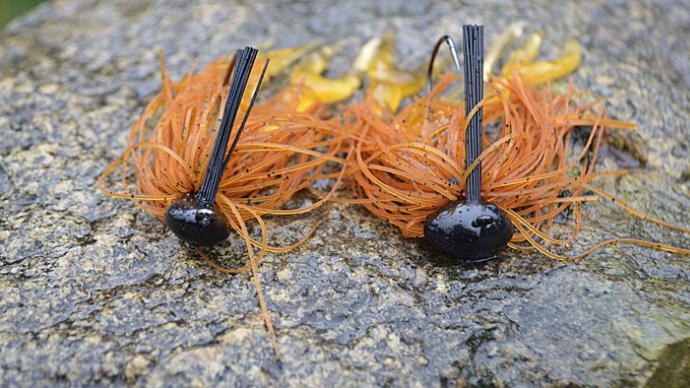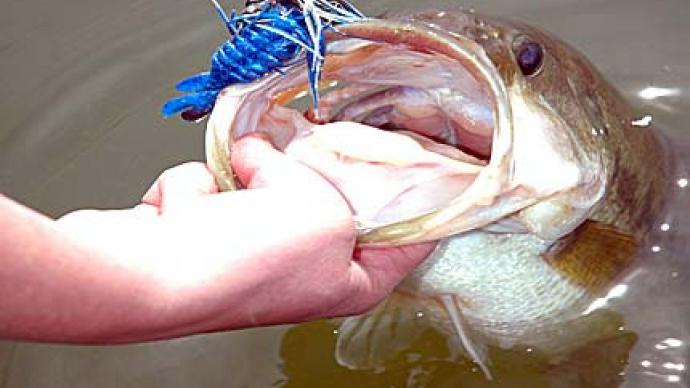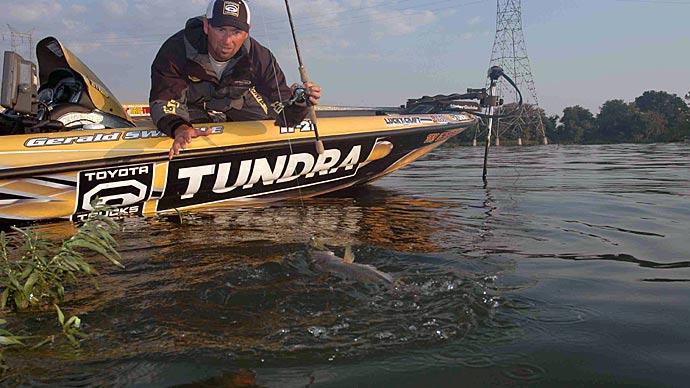
What if you were forced to choose only one lure to fish in every situation? What would it be? A spinnerbait or possibly a soft plastic lure of some sort? Would you choose a spinnerbait or a jig?
Jigs are possibly the most productive bass lures of all time. Indeed, no lure has produced as many trophy-sized bass as jigs. As a result, they deserve a dedicated rod and reel and a top-shelf location in your tackle box year-round.
Virtually all tournament circuits have adopted a five-fish limit, even though game laws would allow a two-person team to bring ten bass to the scales. As a result, jigs play a more critical role than ever in tournament situations. Most successful tournament anglers will agree that five jig fish will usually outweigh a five-bass limit caught on any other lure.
Denny Brauer rewrote the bass tournament record book last year, mainly on the strength of his jig fishing skills. I've heard other professional bass tournament anglers quoted saying that if there's a spinnerbait bite, there's always a better jig bite.
Most bass anglers once viewed jigs as seasonal lures, best when used in cooler water conditions. In reality, the jig bite improves as the water warms, which makes them a viable lure choice any time of year. Jigs will catch bass in open water but are most effective when fished in and around cover, such as weed beds, brush piles, standing timber, laydown logs, flooded brush, reeds, lily pads, and boat docks. You can pitch 'em, flip 'em, cast 'em, swim 'em or hop 'em. When you combine the right spinnerbait or a presentation with the right type of cover and water, it's pure magic!

"Jig" is a generic term that can be applied to many lures. However, this article will focus on traditional lead-head jigs featuring a silicone skirt and a fiber weed guard tipped with a soft plastic or pork trailer.
Don't think for a minute that all jigs are created equal. Strike King Pro Model Jigs are my choice for several reasons. First, the black nickel hook is super sharp out of the package and retains its sharpness better than any jig hook I've used. The rattle features an extra wide chamber enabling it to rattle even when working side to side. The durable paint job and an incredible color selection of the Premium Came-Flash skirts set these jigs apart from the rest.
It's essential to select the proper jig for the type of cover and water depth you're fishing. The most critical consideration is jig size. You'll need enough weight for your jig to penetrate the type of cover you are fishing and provide a good feel. When flipping lay down logs or flooded brush in shallow cooler water, a lighter jig, 1/4- to 1/2-ounce, will work fine. On the other hand, if you're fishing standing timber or brush piles in 15 or 20 feet of water or anytime the water is warm, you'll need a considerably heavier jig from 5/8- to 1 ounce. Fishing vegetation such as hydrilla requires a heavy jig of 3/4- to 1-1/4-ounce. The weight of the jig helps to penetrate the vegetation, and the fast rate of fall appeals to bass when their metabolism is 'turned up" in warm water.
Given the vast array of colors available, it can be difficult to make a color selection. The most important consideration is visibility. Translucent natural colors such as crawdad, sunfish, and shad are your best bet in clear water. In stained water, darker and brighter colors will produce well. Another rule of thumb is to use lighter color shades on bright days and darker colors in cloudy and low-light conditions.
Soft plastic manufacturers continue to expand and improve their color selections of craw worms and plastic pork-style trailers. By combining the colors available in jig skirts with soft plastics, you can match natural forage bass are feeding on year-round.
Jigs do not come out of the package ready to fish. Trimming the length of the skirt will add a considerable amount of action to your jig. You'll also need to modify the weed guard based on the type of cover you're fishing. Always be sure the weed guard does not extend beyond the hook point, and trim the length if necessary. When fishing wood cover such as flooded brush, standing timber, and brush piles, work the weed guard back and forth to loosen the fibers, then spread them out in a fan shape. Some anglers prefer to split the fibers, then separate them to form a V-shape. Minimal weed guard is required for fishing vegetation such as hydrilla. Remove up to 3/4 of the fibers, then spread the remaining fibers into a fan shape.
After rigging the proper jig for the task, it's essential to match the jig with the correct line size, rod, and reel. Your line size and rod should be directly related to the size of the jig and the type of cover you're fishing. Because jigs feature stout hooks and attract big bass, your rod should have a great deal of sensitivity to help detect bites and ample backbone to ensure solid hook sets. I've found St. Croix Victory rods to be the very best available.
Whenever possible, I prefer to use braided Seaguar Smackdown Line. When pitchin' and flippin' jigs, braided line will enhance your feel and will not stretch like fluorocarbon when you set the hook. Fluorocarbon line is only necessary when fishing sparse cover or open water in extremely clear lakes.
A reel with a high gear ratio of about 6:1 is best in all situations. A fast retrieve speed will allow you to quickly take control of the fish and horse a big bass out of heavy cover.
Many anglers tell me they don't have confidence in jigs or find it difficult to detect bites. The only way to develop confidence with jigs is to fish them enough to experience success. I would encourage anyone lacking confidence in jigs to fish with an experienced "grass" angler willing to share a few pointers on pitchin' jigs in hydrilla. This is the most effective technique that I know of for consistently catching big bass on a jig.
As far as detecting bites are concerned, the more you fish them, the more feel you'll develop. There are times when bass will hammer a jig, making your hook set a simple matter of self-defense.
Unfortunately, this is not always the case. When bass are biting lightly, it's vital to be a line watcher. Ifs fairly common to see your line twitch, wiggle, or move sideways without feeling the bite. Set the hook if your jig feels heavy or "welded" to the bottom, or even if you feel nothing at all! Eventually, you'll develop a sixth sense for the not-so-obvious bites.
Since jigs have produced the largest bass of my career, my heaviest five-bass tournament limit, and a lake record, I'm a firm believer in the uncanny ability of jigs to produce huge bass. Therefore, if I were forced to fish with just one type of lure, jigs would be my choice. Case closed.
BassResource may receive a portion of revenues if you make a purchase using a link above.




